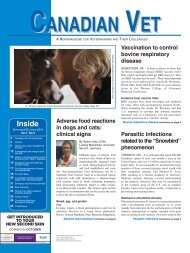canadian vet - K2 Animal Health Publishing
canadian vet - K2 Animal Health Publishing
canadian vet - K2 Animal Health Publishing
Create successful ePaper yourself
Turn your PDF publications into a flip-book with our unique Google optimized e-Paper software.
May/June 2012 Canadian Vet13<br />
Treatment of clinical mastitis: strategies to improve economics of therapy<br />
HALIFAX, NS – Mastitis is the<br />
most costly infectious disease<br />
on dairy farms and is the most<br />
frequent cause of antibiotic<br />
use, explained Greg Keefe, DVM,<br />
speaking at the Canadian<br />
Veterinary Medical Association<br />
Conference. The cost is largely<br />
attributed to the necessity<br />
of withholding milk due to<br />
residue concerns. In Canada<br />
over one half of antibiotic use<br />
in the dairy industry is to treat<br />
or prevent mastitis. There is<br />
public concern that the use of<br />
antibiotics in agriculture may<br />
lead to antimicrobial resistance<br />
in humans. Dr. Keefe said that<br />
<strong>vet</strong>erinarians have to be judicious<br />
in their use of antibiotics, but<br />
questioned whether it is humane<br />
to withhold treatment if it is<br />
beneficial to the animal. He said<br />
that judicious use may not mean<br />
reduced use in all cases. In fact,<br />
some circumstances may benefit<br />
from increased use, while others<br />
require less or no antibiotic use<br />
at all.<br />
Treatment decisions<br />
Clinical mastitis is inflammation<br />
in the udder in response to<br />
infection from a wide range of<br />
bacteria. Dr. Keefe said that<br />
when designing a treatment<br />
regime, it is important to know<br />
what the causative organism is in<br />
order to choose an antimicrobial<br />
with an appropriate spectrum of<br />
activity. A recent Canadian study<br />
reported that about 40% of milk<br />
samples submitted from cows<br />
with clinical mastitis yielded no<br />
bacterial growth. Additionally,<br />
early studies found no difference<br />
in clinical or bacteriological<br />
cure rates in mastitis cases<br />
treated with antibiotics versus<br />
those treated with oxytocin.<br />
However recurrence rates were<br />
higher for cases caused by<br />
certain organisms, if they were<br />
untreated. It has been estimated<br />
that antibiotics may not be<br />
justified in 50-80% of clinical<br />
mastitis cases.<br />
He stressed that antimicrobial<br />
therapy should only be used for<br />
pathogen groups where there is<br />
strong evidence of benefit, saying<br />
that by treating fewer cases with<br />
antibiotics and discarding less<br />
milk that contains residue, the<br />
cost per case of mastitis can be reduced. One method to<br />
target therapy is to use an on-farm culture system. Over<br />
the last five years, the following two groups in North<br />
America have been working on large clinical trials to<br />
evaluate the short and long-term implications of on-farm<br />
culture driven selective clinical mastitis therapy.<br />
Canadian study<br />
The Canadian Bovine Mastitis Research Network<br />
(CBMRN) study was lead by Dr. Keefe and two of<br />
his graduate students, Dr. Jennifer McCarron and Dr.<br />
Kimberley MacDonald. It began by directly comparing<br />
tools that might be adapted for on-farm use in the Canadian<br />
industry: Petrifilm and University of Minnesota Biplates.<br />
Based on the relative equivalencies of the systems to<br />
predict infection status and their stability properties, the<br />
Canadian study proceeded to the on-farm clinical trial<br />
with the Petrifilm system.<br />
Fifty-four Canadian dairy farms from seven provinces<br />
were enrolled in a clinical trial to evaluate the utility<br />
Clinical mastitis continues on page 16





